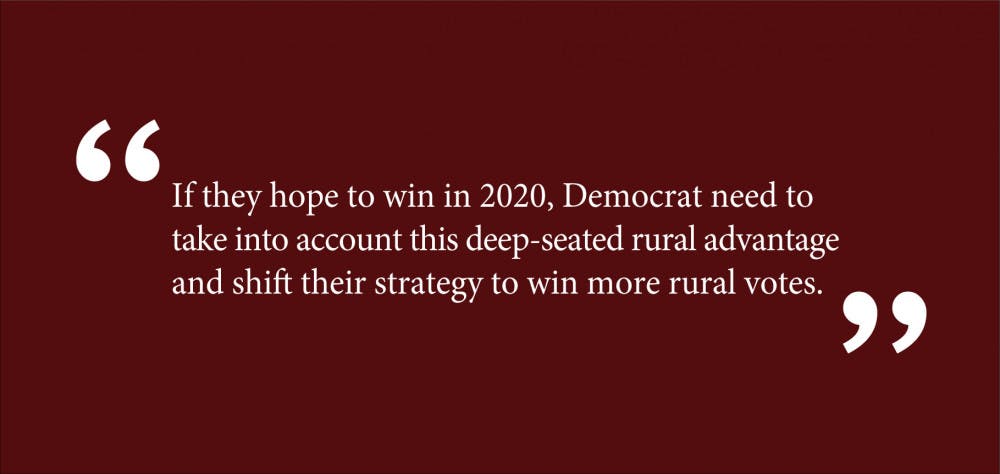After the 2016 presidential election, political airwaves seemed dominated by two refrains:
“Donald Trump is our president!”
“Actually, Hillary won the popular vote.”
Both statements are equally valid. Despite their gripes, liberals could not deny that Donald Trump would occupy the Oval Office. On the other hand, perhaps Republians should have qualified their enthusiasm by acknowledging that their candidate spoke for a minority of the American people.
These opposing outlooks are rooted in an underlying issue that is more complex than mere partisanship. The 2016 election is proof of a system that disproportionately rewards the rural vote. In vying for control of the House of Representatives, the Senate and the presidency, urban political voices are at a disadvantage because of the outsized influence that sparsely populated states hold in our electoral system. The result is that representation in the federal government fails to adequately reflect public opinion. In an age of polarization along geographical lines, Democrats are the ones who lose out. If they hope to win in 2020, Democrats need to take into account this deep-seated rural advantage and shift their strategy to win more rural votes.
The numbers demonstrate this disconnect between the electoral and popular votes. Over the past few elections for the House of Representatives, Republicans have won a share of seats that is four to five percentage points higher than the portion of the popular vote they garnered. In the 2018 midterms, even as many Republican seats were taken by Democrats, their losses were hedged by gerrymandering — according to one analysis, Democrats’ current advantage in the House would have been 16 seats larger if congressional boundaries had been drawn fairly.
The Senate, where Republicans control 53 seats, is even less representative of the popular vote: The 53 GOP Senators in the hundred-member body represent about 15 million fewer people than the 45 Democrats who sit across the aisle. And in the Electoral College, the five most rural states in America have twice as many electoral votes per resident as the five largest states do.
Believe it or not, the disproportionate representation of small states was a deliberate part of the Framers’ original plan. The Senate, for instance, was intended to guarantee that small states have a meaningful influence in government and are protected from the tyranny of the majority. The Electoral College was designed as a concession to Southern states, protecting the political influence of their voting populations while leaving slaves disenfranchised. The design of the Electoral College system was not a real problem until the 2000 presidential election, when George Bush won the White House through the Electoral College despite earning fewer votes than Al Gore. This was the first time since 1888 that the popular vote and the Electoral College produced opposite verdicts. But now that the previous two Republican presidents won in this manner, it is time for Democrats to take notice.
Why now, at the start of the new millennium, does the Electoral College fail to represent the views of the majority of Americans? Over the past few decades, geography has increasingly come to predict party affiliation: The Democratic Party now largely represents cities, while the Republican Party largely represents rural America. Before this sociopolitical sorting intensified at the end of the 20th century, the Constitution’s bias against voters in major population centers affected both parties about equally. Republicans depended on moderate Eastern elites, such as the Rockefeller Republicans, as much as they did on social conservatives to form winning coalitions. Democrats, on the other hand, could count on urban political machines such as Tammany Hall, even while they also relied on the “Solid South” for victories, until they lost Southern support with the passage of the Civil Rights Act.
But the era of parties that crossed geographic lines is now a distant memory. The 13 most densely populated states are represented by 121 Democrats and 73 Republicans in the House. The other 37 less densely populated states are represented by 163 Republicans and 72 Democrats. The Republicans are definitively the party of rural America, and so they benefit from the advantages in representation that are built into the Constitution. The Democrats, standard-bearers of cityfolk, must deal with the ramifications.
The upshot is that while the Democrats should be cognizant of the systemic disadvantages they face, they need to reshape their political strategy to better suit the needs of moderate and even conservative voters in places such as the Rust Belt to compete outside of states like New York and California. In practice, they will have a hard time doing so because of the growing progressive wing of the party, which could alienate rural voters who might otherwise consider voting blue.
The challenge facing the Democrats thus adds a new twist to an important question: What exactly do working-class Americans care about? Even if the structural reforms presented by candidates such as Bernie Sanders are popular in urban centers, can they win over enough moderates to overcome our government’s bias against the political influence of the coasts? Just as important: Is Biden’s time-tested message to the Rust Belt enough to rebuild the blue wall?
The two wings of the Democratic Party offer different answers, and it is not clear which will more effectively resonate with voters. But if there is one thing that our broken system of uneven representation should teach Democrats, it is that they need to tailor their message to the highly diverse geographies around the country, not just to the urban centers. Even outside of the cities, our country moves. It breathes. It votes.
Arjun Shanmugam ’23 can be reached at arjun_shanmugam@brown.edu. Please send responses to this opinion to letters@browndailyherald.com and op-eds to opinions@browndailyherald.com.



